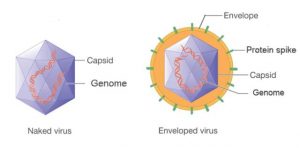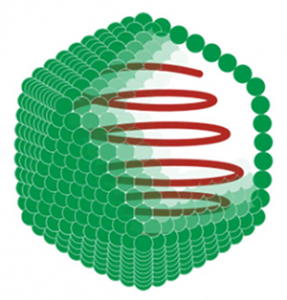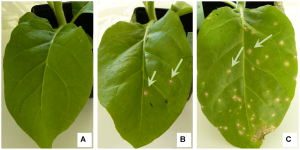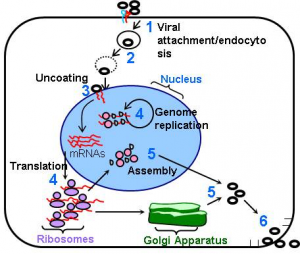Microbes: viruses — DRAFT ONLY
Learning Objectives
Be able to describe a virus.
Know how a virus replicates.
Be able to name 2 common viruses.
2 ways humans benefit and 2 ways humans could be harmed
What are viruses?
Viruses are microscopic parasitic organisms that alternate between two states of activity. When present outside of a host cell, viruses lie dormant and inactive. However, upon locating and entering a host cell, they can quickly reproduce and multiply by using the inner cellular machinery of their host.
They are able to carry out these functions due to their unique structural features, and all viruses share certain common features:
- All viruses contain some form of genetic material, with either DNA or RNA present within the body of the virus
- This body is covered by a capsid, or a protein coat. This helps protect the internal genetic material from being digested by enzymes or other harmful substances, while also helping the virus attach to and penetrate a host cell.
- Many, but not all, viruses also have an envelope, where an additional layer surrounds or envelops the internal capsid. This layer is generally made out of fats and proteins. In certain viruses such as the SARS-CoV-2 virus that causes the coronavirus disease 2019 (COVID-19), this envelope is shaped into spikes that can help the virus latch onto and enter host cells.

Viruses also come in several different shapes, such as:
- Icosahedral, which appear spherical in shape. The outer capsid is made out of identical protein units that from equilateral triangles fused together into a spherical shape. Examples of icosahedral viruses include the rhinovirus, which can cause the common cold.

- Helical, where the capsid encloses a hollow tube made of proteins arranged in a circular manner. These circular discs connect in a fashion similar to a toy slinky, with room in the middle for storage of genetic material. Examples of helical viruses include the tobacco mosaic virus, that causes deformations in leaves as seen in the image below.


- Complex, where the structure has a combination of helical and icosahedral shapes, or a head-tail morphology. This type of head-tail structure is generally seen in bacteriophages, which are viruses that exclusively infect bacteria. However, other complex forms exist, with multiple layers of envelope and capsid proteins or several helical protrusions conjoined to a single structure. Examples of complex viruses include the variola virus, which can cause smallpox.

Viral replication
The structures of a virus help it quickly enter and replicate within a host cell. While different species of viruses replicate in different methods, there are 6 stages that are shared across them
- Attachment or Adsorption
-
-
- Proteins on the outer capsid or envelope layers interact with receptor proteins on the surface of the host cell, binding the two structures together.
-
- Penetration
-
-
- There are different methods by which this process can occur; fusion of the cell and viral membranes can occur to allow the viral material to enter, or cell receptors can endocytose the viral material.
-
- Uncoating
-
-
- This process removes any capsid or envelope proteins that may enclose the viral genetic material, and is done either by viral or host enzymes.
-
- Replication
-
-
- The viral genetic material, which can be either RNA or DNA, is then processed through transcription and translation and is done using the host cell’s ribosomes and golgi apparatus. In addition, viral proteins needed for further growth and spread of the virus are synthesized at this stage.
-
- Assembly or Maturation
-
-
- The viral genome is packaged with the newly synthesized viral proteins into new virus particles that are ready for release.
-
- Release
-
- Two distinct methods of release have been seen in viruses
- Lysis: The virus bursts out of the inner membrane of the host cell, killing it in the process. Viruses that carry out this step are known as cytolytic
- Budding: The virus slowly forms a bud like shape on the membrane of the cell before breaking off, enveloping itself in a layer of the phospholipid membrane in the process. This process does not kill the host cell, and such viruses are called cytopathic.
- Two distinct methods of release have been seen in viruses
-

Uses of viruses
The method of replication used by viruses makes them incredibly pathogenic, and they are capable of causing several problems for humans. The ability of viruses to quickly replicate helps them to evolve at a rapid pace, lowering the efficacy of targeted antiviral therapies such as vaccines. Due to this, viruses can cause a wide range of diseases that can be difficult to treat and manage. These diseases are not exclusive to humans, and viruses can infect and impact plants and other organisms as well. As such, viruses can harm humans in the following ways:
- Disease: Viruses can cause a diverse array of diseases, from the rhinovirus causing the common cold, influenza viruses causing the flu, to various coronaviruses causing a number of respiratory diseases such as COVID-19 and middle east respiratory syndrome (MERS). These diseases can be incredibly deadly to humans, particularly those with weakened immune systems or preexisting conditions. Viruses are also responsible for diseases such as ebola, caused by the ebola virus, and AIDS, caused by the human immunodeficiency virus (HIV).
- Crop loss: Viruses can harm a large number of different plants, stunting growth and lowering yield of various crops. These diseases can be difficult to prevent, and can spread rapidly from plant to plant. Additionally, they can be difficult to treat due to the high genetic diversity that can exist within the same species of virus. Viruses can harm important food crops such as cauliflower, corn, and lettuce in addition to harming important cash crops such as tobacco and sugarcane.

Viruses can also be useful, and their ability to quickly replicate and destroy other organisms can be harnessed for human use:
- Protective phages: Complex viruses known as bacteriophages tend to target and destroy specific species of bacteria. Research has recently suggested that phages that live within the mucus membrane of a human digestive tract feed off of various invading bacteria that enter the human body. This prevents these invasive bacteria from colonising that particular region of the digestive tract and causing a bacterial infection. These viruses have evolved alongside the human body, allowing them to live within the ecosystem of the body without detection and destruction by the immune system.
- Experimental treatments: Research has experimented with the use of phages for treatment of various diseases. In particular, phage therapy is being explored as a form of managing the spread of cancer, with phages being used to exclusively target cancer cells while leaving healthy cells intact. Additionally, viruses are being studied as vehicles through which gene therapy can be safely administered. The ability of a virus to insert its own set of genetic material into a host cell is being studied as a method through which helpful genes can be inserted into targeted cells.

